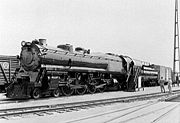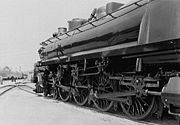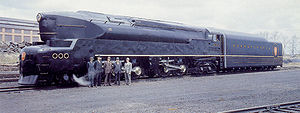
4-4-4-4
Encyclopedia



Steam locomotive
A steam locomotive is a railway locomotive that produces its power through a steam engine. These locomotives are fueled by burning some combustible material, usually coal, wood or oil, to produce steam in a boiler, which drives the steam engine...
, in the Whyte notation
Whyte notation
The Whyte notation for classifying steam locomotives by wheel arrangement was devised by Frederick Methvan Whyte and came into use in the early twentieth century encouraged by an editorial in American Engineer and Railroad Journal...
for describing locomotive
Locomotive
A locomotive is a railway vehicle that provides the motive power for a train. The word originates from the Latin loco – "from a place", ablative of locus, "place" + Medieval Latin motivus, "causing motion", and is a shortened form of the term locomotive engine, first used in the early 19th...
wheel arrangement
Wheel arrangement
In rail transport, a wheel arrangement is a system of classifying the way in which wheels are distributed beneath a locomotive.. Several notations exist to describe the wheel assemblies of a locomotive by type, position, and connections, with the adopted notations varying by country...
s, has a four-wheel leading truck, two sets of four driving wheel
Driving wheel
On a steam locomotive, a driving wheel is a powered wheel which is driven by the locomotive's pistons...
s, and a four-wheel trailing truck.
Other equivalent classifications are:
UIC classification
UIC classification
The UIC classification of locomotive axle arrangements describes the wheel arrangement of locomotives, multiple units and trams. It is set out in the International Union of Railways "Leaflet 650 - Standard designation of axle arrangement on locomotives and multiple-unit sets". It is used in much...
: 2BB2 (also known as German classification and Italian classification)
French classification: 2222
Turkish classification
Turkish classification
In the Turkish classification system for railway locomotives, the number of powered axles are followed by the total number of axles. It is identical to the Swiss system except that the latter places a slash between the two numbers.Thus0-6-0 becomes 33...
: 2424
Swiss classification: 2/4+2/4 up to the early 1920's, later 4/8
While it would be possible to make an articulated locomotive
Articulated locomotive
Articulated locomotive usually means a steam locomotive with one or more engine units which can move independent of the main frame. This is done to allow a longer locomotive to negotiate tighter curves...
of this arrangement, the only 4-4-4-4s ever built were duplex locomotive
Duplex locomotive
A duplex locomotive is a steam locomotive that divides the driving force on its wheels by using two pairs of cylinders rigidly mounted to a single locomotive frame; it is not an articulated locomotive...
s—with two sets of cylinders driving two sets of driven wheels in one rigid frame.
The first locomotive built with this arrangement was the Baltimore and Ohio Railroad
Baltimore and Ohio Railroad
The Baltimore and Ohio Railroad was one of the oldest railroads in the United States and the first common carrier railroad. It came into being mostly because the city of Baltimore wanted to compete with the newly constructed Erie Canal and another canal being proposed by Pennsylvania, which...
's sole class N-1 #5600 George H. Emerson
Baltimore and Ohio Class N-1
The Baltimore and Ohio Railroad's sole Class N-1 steam locomotive, #5600 George H. Emerson, was the first duplex locomotive and the first 4-4-4-4 locomotive ever built. It was designed and built by the railroad's own shops in 1937. The rear set of cylinders were placed beside the firebox. This...
. To reduce the fixed wheelbase, this locomotive had the two sets of cylinders at opposite ends, so that the rear pair were beside the firebox. This proved to be a poor design, as it restricted the firebox size and exposed the cylinders to dust and dirt, causing premature wear. The locomotive was not considered successful enough to duplicate.
Next were the Pennsylvania Railroad
Pennsylvania Railroad
The Pennsylvania Railroad was an American Class I railroad, founded in 1846. Commonly referred to as the "Pennsy", the PRR was headquartered in Philadelphia, Pennsylvania....
's 52 class T1
PRR T1
The Pennsylvania Railroad's 52 T1 class duplex-drive 4-4-4-4 steam locomotives, introduced in 1942 and 1946 , were their last-built steam locomotives and their most controversial. They were ambitious, technologically sophisticated, powerful, fast, and uniquely streamlined by Raymond Loewy...
locomotives. These had the cylinders in front of the wheels they drove, so that the rear pair were between the two sets of drivers. These locomotives were impressive performers but suffered from wheelslip and severe reliability problems, and did not last long in service.

